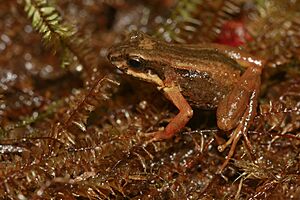Martinique volcano frog facts for kids
Quick facts for kids Martinique volcano frog |
|
|---|---|
 |
|
| Conservation status | |
| Scientific classification | |
| Synonyms | |
|
Colostethus chalcopis Kaiser, Coloma, and Gray, 1994 |
The Martinique volcano frog (scientific name: Allobates chalcopis) is a special kind of frog. It's also known as the ravine rocket frog. This tiny frog lives only on the island of Martinique in the Caribbean. You can find it high up in the mountains, like on Mount Pelée.
This frog is very unique because it's the only type of "aromobatid" frog that lives on an oceanic island. Scientists first thought it might have come from somewhere else. But after studying new frogs and using modern methods, they found it's truly different. This means it is a real native species of Martinique.
What Does It Look Like?
The Martinique volcano frog is quite small. Male frogs are about 17 millimeters (0.67 inches) long from their snout to their rear. Female frogs are a little bit bigger, around 16 to 18 millimeters (0.63 to 0.71 inches).
Their back (called the dorsum) is light brown. It often has darker patterns. Male frogs have a unique black throat that fades to dark gray. Female frogs have a pale orange throat and belly.
Tadpoles: How They Grow
The baby frogs, called tadpoles, are also special. They live on land, not in water. They don't eat anything! Instead, they use stored food from their egg yolk to grow. This is called being "endotrophic."
These tadpoles can grow to be at least 12 millimeters (0.47 inches) long. Their body is flat on the bottom.
Where Does It Live?
The Martinique volcano frog was first found in the forests of Mount Pelée. This was at an elevation of about 500 meters (1,600 feet) above sea level.
In 2011, scientists looked for the frog in these lower areas but couldn't find it. They discovered it higher up on the mountain. It was living between 800 and 1,400 meters (2,600 to 4,600 feet) above sea level, all the way to the top!
The frog's current home starts where the forest meets the savanna. Savanna is a type of grassland found higher up the mountain. In 2012, the frog was also found on Piton Boucher. This peak is part of the Carbet Mountains, southeast of Mount Pelée. It was found there at 1,000 meters (3,300 feet) above sea level. It might also live on other peaks in the Carbet Mountains.
Why Is It Endangered?
The International Union for Conservation of Nature (IUCN) first listed the Martinique volcano frog as "Vulnerable" in 2010. This meant it was at risk.
However, things got worse. The frog has disappeared from lower parts of its home because of climate change. Its remaining living area is now very small. Because of this, the IUCN reclassified it as "Critically Endangered" in 2021. This means it faces a very high risk of disappearing forever.


